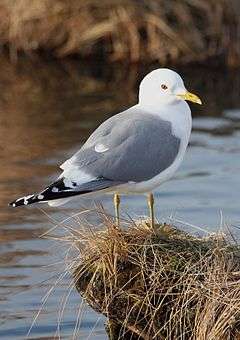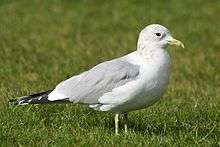Common gull
- For the common gull butterfly, see Cepora nerissa.
| Common gull | |
|---|---|
 | |
| Adult mew gull. Anchorage Coastal Wildlife Refuge, Alaska. | |
| Scientific classification | |
| Kingdom: | Animalia |
| Phylum: | Chordata |
| Class: | Aves |
| Order: | Charadriiformes |
| Family: | Laridae |
| Genus: | Larus |
| Species: | L. canus |
| Binomial name | |
| Larus canus Linnaeus, 1758 | |
The common gull (European and Asian subspecies; see below) or mew gull (North American subspecies) Larus canus is a medium-sized gull which breeds in northern Asia, northern Europe and northwestern North America. It migrates further south in winter.[2] Its name does not indicate that it is an abundant species, but that during the winter it feeds on common land, short pasture used for grazing.[3]
Description
Adult common gulls are 40–46 cm long, noticeably smaller than the herring gull, and slightly smaller than the ring-billed gull, also differing from the latter in its shorter, more tapered bill with a more greenish shade of yellow, as well as being unmarked during the breeding season. The body is grey above and white below. The legs are greenish-yellow. In winter, the head is streaked grey, and the bill often has a poorly defined blackish band near the tip (sometimes sufficiently obvious to cause confusion with ring-billed gull). They have black wingtips with large white "mirrors". Young birds have scaly black-brown upperparts and a neat wing pattern, and grey legs. They take two to three years to reach maturity. The call is a high-pitched "laughing" cry.[2][4]
Taxonomy
There are four subspecies, two of them considered distinct species by some authorities:[2][5]
- Larus canus canus Linnaeus, 1758 – common gull. Europe and western Asia. Small; mantle medium grey (palest subspecies); wingtips with extensive black; iris dark. Wingspan 110–125 cm; mass 290–480 g.
- Larus canus heinei Homeyer, 1853 – Russian common gull. Central northern Asia. Medium size; mantle dark grey (darkest subspecies); wingtips with extensive black; iris dark. Mass 315–550 g.
- Larus canus kamtschatschensis Bonaparte, 1857; syn. L. kamtschatschensis – Kamchatka gull. Northeastern Asia. Large; mantle medium-dark grey; wingtips with extensive black; iris pale. Mass 394–586 g.
- Larus canus brachyrhynchus Richardson, 1831; syn. L. brachyrhynchus – mew gull or short-billed gull. Alaska and western Canada. Small; mantle medium-dark grey; wingtips with little black and much white; iris pale. Wingspan 96–102 cm; mass 320–550 g.
Ecology

Both common and mew gulls breed colonially near water or in marshes, making a lined nest on the ground or in a small tree; colony size varies from 2 to 320 or even more pairs. Usually three eggs are laid (sometimes just one or two); they hatch after 24–26 days, with the chicks fledging after a further 30–35 days. Like most gulls, they are omnivores and will scavenge as well as hunt small prey. The global population is estimated to be about one million pairs; they are most numerous in Europe, with over half (possibly as much as 80-90%) of the world population.[6] By contrast, the Alaskan population is only about 10,000 pairs.[2]
Vagrancy
The common gull occurs as a scarce winter visitor to coastal eastern Canada and as a vagrant to the northeastern USA,[7] and there is one recent record of mew gull in Europe on the Azores.[8]
Etymology
The scientific name Larus canus simply translates from Latin as grey or hoary gull.[9] The name common gull was coined by Thomas Pennant in 1768 because he considered it the most numerous of its genus.[10] John Ray earlier used the name common sea-mall.[10] It is something of a cliche that uncommon gull is a more accurate description. There are many old British regional names for this species with variations on maa, mar and mew.[11]

References
- ↑ BirdLife International (2012). "Larus canus". IUCN Red List of Threatened Species. Version 2013.2. International Union for Conservation of Nature. Retrieved 26 November 2013.
- 1 2 3 4 del Hoyo, J., et al., eds. (1998). Handbook of the Birds of the World 3: 621. Lynx Edicions ISBN 84-87334-20-2.
- ↑ Okill, Dave (2004) English names for Western Palearctic birds British Birds 97(7): 348-9
- ↑ Snow, D. W. & Perrins, C. M. (1998). The Birds of the Western Palearctic Concise Edition. OUP ISBN 0-19-854099-X.
- ↑ Olsen, K. M., & Larsson, H. (2004). Gulls of Europe, Asia and North America. Helm ISBN 0-7136-7087-8.
- ↑ Hagemeijer, W. J. M., & Blair, M. J., eds. (1997). The EBCC Atlas of European Breeding Birds. Poyser, London ISBN 0-85661-091-7.
- ↑ Sibley, D. (2000). The Sibley Guide to Birds. ISBN 0-679-45122-6.
- ↑ Alfrey, P., & Ahmad, M. (2007). Short-billed Gull on Terceira, Azores, in February–March 2003 and identification of the 'Mew Gull complex'. Dutch Birding 29 (4): 201-212.
- ↑ Jobling, James A (1991). A Dictionary of Scientific Bird Names. OUP. ISBN 0-19-854634-3.
- 1 2 Lockwood, W B (1993). The Oxford Dictionary of British Bird Names. OUP. ISBN 978-0-19-866196-2.
- ↑ Jackson, Christine E. (1968). British Names of Birds. Witherby.
- "National Geographic" Field Guide to the Birds of North America ISBN 0-7922-6877-6
- Seabirds, an Identification Guide by Peter Harrison, (1983) ISBN 0-7470-1410-8
External links
| Wikimedia Commons has media related to the common gull. |
- Common Gull videos, photos & sounds on the Internet Bird Collection
|
